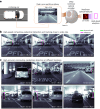Nonlinear optical encoding enabled by recurrent linear scattering
- PMID: 39372105
- PMCID: PMC11449782
- DOI: 10.1038/s41566-024-01493-0
Nonlinear optical encoding enabled by recurrent linear scattering
Abstract
Optical information processing and computing can potentially offer enhanced performance, scalability and energy efficiency. However, achieving nonlinearity-a critical component of computation-remains challenging in the optical domain. Here we introduce a design that leverages a multiple-scattering cavity to passively induce optical nonlinear random mapping with a continuous-wave laser at a low power. Each scattering event effectively mixes information from different areas of a spatial light modulator, resulting in a highly nonlinear mapping between the input data and output pattern. We demonstrate that our design retains vital information even when the readout dimensionality is reduced, thereby enabling optical data compression. This capability allows our optical platforms to offer efficient optical information processing solutions across applications. We demonstrate our design's efficacy across tasks, including classification, image reconstruction, keypoint detection and object detection, all of which are achieved through optical data compression combined with a digital decoder. In particular, high performance at extreme compression ratios is observed in real-time pedestrian detection. Our findings open pathways for novel algorithms and unconventional architectural designs for optical computing.
Keywords: Applied optics; Imaging and sensing; Optical techniques; Photonic devices; Techniques and instrumentation.
© The Author(s) 2024.
Conflict of interest statement
Competing interestsThe authors declare no competing interests.
Figures




Similar articles
-
Large-scale photonic computing with nonlinear disordered media.Nat Comput Sci. 2024 Jun;4(6):429-439. doi: 10.1038/s43588-024-00644-1. Epub 2024 Jun 14. Nat Comput Sci. 2024. PMID: 38877122
-
Neuromorphic Computing via Fission-based Broadband Frequency Generation.Adv Sci (Weinh). 2023 Dec;10(35):e2303835. doi: 10.1002/advs.202303835. Epub 2023 Oct 2. Adv Sci (Weinh). 2023. PMID: 37786262 Free PMC article.
-
Photonic reservoir computing based on nonlinear wave dynamics at microscale.Sci Rep. 2019 Dec 13;9(1):19078. doi: 10.1038/s41598-019-55247-y. Sci Rep. 2019. PMID: 31836737 Free PMC article.
-
Nonlinear Optics in Microspherical Resonators.Micromachines (Basel). 2020 Mar 13;11(3):303. doi: 10.3390/mi11030303. Micromachines (Basel). 2020. PMID: 32183230 Free PMC article. Review.
-
An Introduction to Nonlinear Integrated Photonics: Structures and Devices.Micromachines (Basel). 2023 Mar 7;14(3):614. doi: 10.3390/mi14030614. Micromachines (Basel). 2023. PMID: 36985020 Free PMC article. Review.
Cited by
-
Transferable polychromatic optical encoder for neural networks.Nat Commun. 2025 Jul 1;16(1):5623. doi: 10.1038/s41467-025-61338-4. Nat Commun. 2025. PMID: 40593885 Free PMC article.
-
Quantum equilibrium propagation for efficient training of quantum systems based on Onsager reciprocity.Nat Commun. 2025 Jul 17;16(1):6595. doi: 10.1038/s41467-025-61665-6. Nat Commun. 2025. PMID: 40675992 Free PMC article.
-
Nonlinear inference capacity of fiber-optical extreme learning machines.Nanophotonics. 2025 Jun 23;14(16):2749-2760. doi: 10.1515/nanoph-2025-0045. eCollection 2025 Aug. Nanophotonics. 2025. PMID: 40800248 Free PMC article.
-
Optical generative models.Nature. 2025 Aug;644(8078):903-911. doi: 10.1038/s41586-025-09446-5. Epub 2025 Aug 27. Nature. 2025. PMID: 40866675 Free PMC article.
-
Bistable random momentum transfer in a linear on-chip resonator.Proc Natl Acad Sci U S A. 2025 Jul 22;122(29):e2502921122. doi: 10.1073/pnas.2502921122. Epub 2025 Jul 17. Proc Natl Acad Sci U S A. 2025. PMID: 40674415
References
-
- Prucnal, P. R. & Shastri, B. J. Neuromorphic Photonics (CRC Press, 2017).
-
- Kues, M. On-chip generation of high-dimensional entangled quantum states and their coherent control. Nature546, 622–626 (2017). - PubMed
-
- Xu, X. 11 TOPS photonic convolutional accelerator for optical neural networks. Nature589, 44–51 (2021). - PubMed
-
- Wetzstein, G. Inference in artificial intelligence with deep optics and photonics. Nature588, 39–47 (2020). - PubMed
-
- Shastri, B. J. Photonics for artificial intelligence and neuromorphic computing. Nat. Photon.15, 102–114 (2021).
LinkOut - more resources
Full Text Sources
